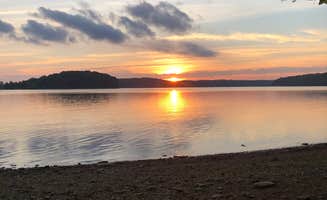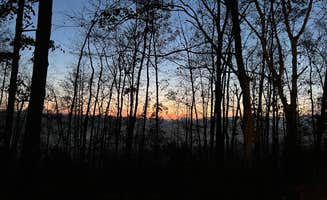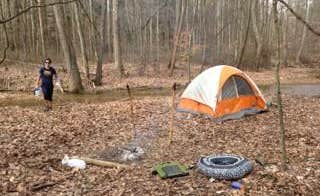Dispersed camping sites spread throughout the Hoosier National Forest near Heltonville, Indiana range from secluded forest locations to waterside spots. Free camping near Heltonville requires no reservations but follows standard National Forest rules including 14-day stay limits and proper waste disposal. The terrain includes moderate hills with elevation changes of 200-300 feet between ridge tops and creek beds across predominantly oak-hickory forest.
What to do
Hike through varied terrain: Peninsula Trail offers accessible hiking with numerous primitive campsites. One visitor noted, "The Peninsula Trail and Grub Ridge trails both have marked campsites that are very far apart and totally private. These are dispersed/primitive sites with a fire ring only." The trail system provides moderate challenges suitable for most experience levels.
Watch wildlife: Wildlife viewing opportunities abound throughout the region, particularly at Peninsula Trail. "Went there with my kids and wife, we had a really great time. Primitive camping at its finest," reported one camper who recommended bringing plenty of drinking water as the hike to water sources can be lengthy.
Stargazing: The minimal light pollution creates excellent night sky viewing opportunities. A camper at Hickory Ridge Primitive Dispersed Campsites shared, "I pulled in at midnight in a sedan in the winter and i was able to safely find my way. Very nice drive during the day, hiking is fantastic!" The area offers clear views of constellations and occasional meteor showers due to limited ambient light.
What campers like
True solitude: Many campers cite the genuine isolation found at these sites as a primary draw. A visitor to Berry Ridge Road - Dispersed Camping commented, "Solo camped here with my dogs. First time I've ever been camping but this spot was really cool. Clean. Secluded and peaceful."
Natural soundscape: The forest setting provides a natural soundtrack away from urban noise. One camper described it as "just trees knocking, bugs curling and frogs croaking." Wildlife sounds commonly include owls, coyotes, and numerous songbird species.
Self-sufficient setup: The primitive nature appeals to campers seeking independence from developed facilities. A Berry Ridge Road visitor explained, "For those of you who don't understand disperse camping this is the perfect site for a tent to camp without anything but what you bring in and take out."
What you should know
Vehicle considerations: Access roads can challenge larger vehicles or those without adequate clearance. A reviewer at Sundance Lake Dispersed Camping advised, "I wouldn't be trying to pull a travel trailer back into here unless it was very small." Most access roads consist of gravel with occasional steep sections.
Weather impacts: Rain can significantly affect road conditions and campsite accessibility. Thunderstorms occur frequently during summer months, with flash flooding possible in low-lying areas. Winter brings occasional snow and icy conditions from December through February.
Visitor patterns: Weekday visits typically offer greater solitude than weekends. At Sundance Lake, a camper observed, "On the weekends, the activity picked up with a lot of partying and hunting. There were a few pickups that patrolled through here regularly, all through the night too."
Tips for camping with families
Accessible locations: Some sites offer easier access than others for families with young children. A visitor to Hickory Ridge recommended it as a "Good spot to get some quality time with the family while being plugged into nature and unplugged from their electronics." Sites closer to main roads minimize hiking distance with gear.
Water planning: No potable water exists at dispersed sites, requiring careful planning. One Peninsula Trail camper advised, "Long walk to the water so make sure you bring plenty of drinking water." Plan for 1 gallon per person per day, especially during summer months.
Safety considerations: Wildlife awareness remains important for families. A camper cautioned, "Springs available in the valleys but watch for timber rattlesnakes." Teaching children proper food storage and waste disposal helps minimize wildlife encounters.
Tips from RVers
Size limitations: Small to medium-sized vehicles navigate forest roads most successfully. A Berry Ridge Road camper stated, "Beautiful secluded site that is pretty far off of the road, but not too far. I have a promaster conversion and had no trouble making it to this site, however the road was gravel and steep at times."
Turning space: Limited turning areas restrict larger RVs throughout most sites. Consider scouting potential campsites before committing to a location with a larger vehicle. Most pull-offs accommodate vehicles under 25 feet in length.
Road conditions: Gravel forest roads require careful navigation, especially in wet conditions. One camper at BerryRidge Road Dispersed Camping described it as "A hidden gem. Just a few sites along the road minimum traffic encountered." Lower tire pressure slightly on gravel roads for improved traction and comfort.




